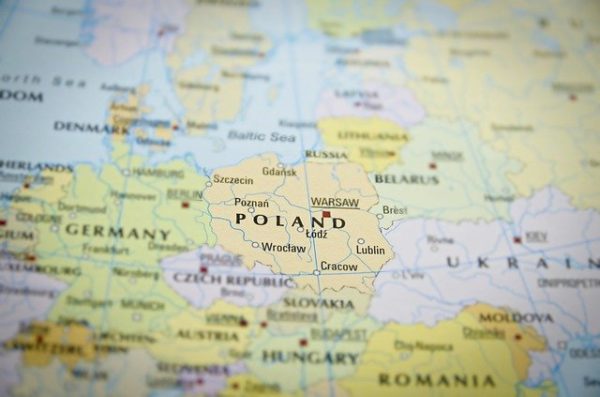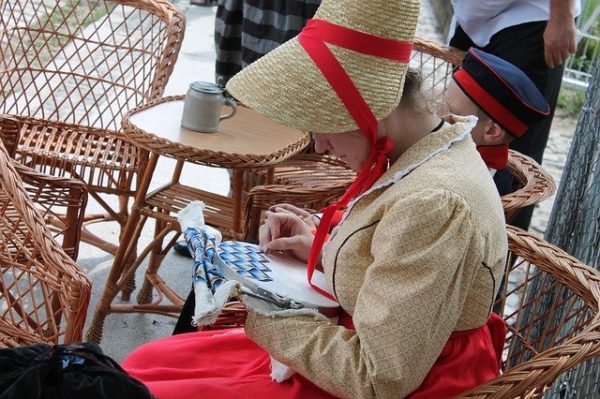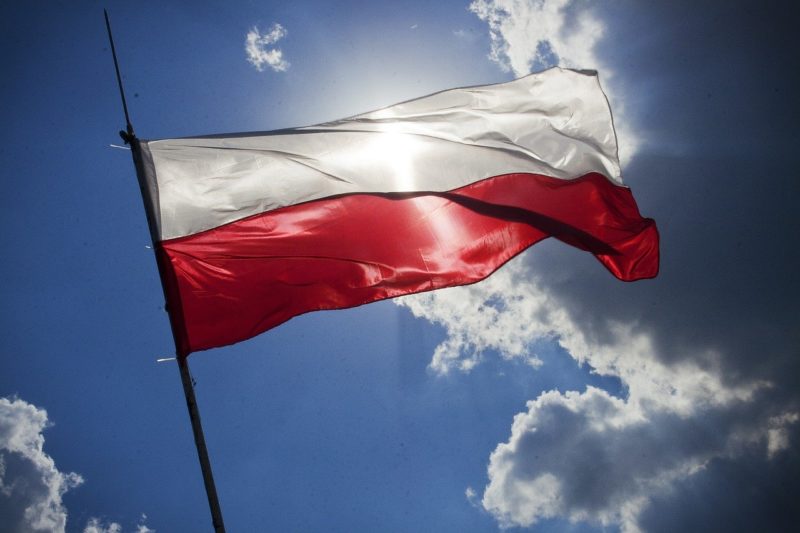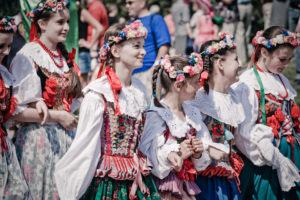Find Out Everything About the Polish Language
Polish is an awesome language. And just like Poland, it has a long and sometimes brutal history. But, learning about the history of the Polish can definitely help you understand the beauty and complexity of the language. Here is every fact, figure, grammar rule, current use, dialect, and sound that you need to discover about the Polish language. Perhaps, this will motivate you to start learning Polish too.
Polish Language Overview
Polish is the official language of Poland. Interestingly, 97% of the Polish population holds the Polish language as their native language. Officially, this makes Poland the most linguistically homogenous country in Europe.
Polish is part of the Slavic language family. This means that it’s related to Russian, Ukranian, Czech, Slovak, and Belarusian. In fact, Polish is the second most widely spoken Slavic language after Russian. There are over 40 million Polish speakers worldwide. Most of these people live in Poland, but there are significant Polish-speaking communities in Germany, Russia, the UK, and the United States.

The History of the Polish Language
Polish’s roots started with Proto-Slavic around the year 500 CE. Proto-Slavic diverged into three separate branches by 1000: West-Slavic, South-Slavic, and East-Slavic. Polish is part of the West-Slavic branch. This means that the most closely related languages to Polish are Czech and Slovak.
Poland first became a state in the 10th century. The unification of Slavic tribes definitely helped establish a common language. Soon after, Poland became a Christian state, which meant the adoption of Latin into the liturgical and administrative language. But, Polish was still the language everyday people used.
The adoption of Latin meant that Latin letters were familiar to Polish people. Soon, they began to use the same letters you know from English to write Polish words. So, even today, Polish uses the Latin alphabet.
The Polish Language Through the Ages
During the Jagellionian era of Poland (1386-1569) Polish became an official language alongside Latin. The country also came into closer contact with Germany, and a lot of German loanwords entered the Polish vocabulary.
Polish was still an official language during the Polish-Lithuanian Commonwealth. But, it actually became more common with the nobility, and more and more people used Polish.
The 16th century in Poland was a defining age for Polish literature. This is called the “Golden Age” of Polish literature in literary studies. Through this, Polish became the lingua franca in Northeastern Europe. Since at this time, Ruthenian was the third official language of the Polish-Lithuanian Commonwealth, it also influenced Polish to some extent. Ruthenian later developed into the Ukrainian and Belarusian dialects.
Between 1795 and 1918 Poland ceased to exist. The land was divided between Russia, Prussia, Austria, and Germany. And the Polish language wasn’t the official language in any of these states. But, luckily, the Polish language survived. And Poland became its own state again after WWI.
The borders were again redrawn after WWII. This meant a forced migration of Polish families to join Poland. A movement of this size within a country meant that dialects mixed together. So, that’s why there’s a lack of differences between regional dialects in Poland today.
Polish Dialects
Poland is quite a large country. Looking at the map, you’d expect a ton of Polish dialects varying by region. But, thanks to the before-mentioned forced migration of Polish dialects, most of them have disappeared or generalized. Today, there are 4 major Polish dialects in Poland. But, these are fairly similar and the only difference is a slight accent.
- Greater Polish:
- Lesser Polish
- Masovian
- Silesian
There’s also Kashubian in Poland, but this is generally considered a different (minority) language.

The Polish Alphabet and Writing System
The Polish alphabet is written with the same Latin letters as English. But, the Polish language has sounds that don’t quite fit the Latin alphabet. So, to be more true to the Polish pronunciation, Polish added various diacritics to show the reader how the text is said out loud. These are: ą, ć, ę, ł, ń, ó, ś, ź, ż, and they’re part of the Polish alphabet now. So, there are 32 letters in total in the Polish alphabet.
A a |
Ą ą |
B b |
C c |
Ć ć |
D d |
E e |
Ę ę |
F f |
G g |
H h |
I i |
J j |
K k |
L l |
Ł ł |
M m |
N n |
Ń ń |
O o |
Ó ó |
P p |
R r |
S s |
Ś ś |
T t |
U u |
W w |
Y y |
Z z |
Ź ź |
Ż ż |
You may have noticed that Q, V, and Y are missing from the alphabet. But, the Polish language doesn’t actually use these three letters. However, you may find them in foreign names and loanwords.
Digraphs and Trigraphs in the Polish Language
Digraphs are a combination of two letters that always have the same sound when they’re together. Kind of how “ph” in English is always an “f” sound. And trigraphs are the same concept, but with three letters. Well, Polish has a number of digraphs and trigraphs that you have to get familiar with early on in your Polish studies.
Polish Digraphs and Trigraphs |
Similar English sound |
Example |
ch |
ch’ as in the Scottish loch |
suche (dry) |
ci |
‘ch’ as in cheek |
ciepło (heat) |
cz |
‘ch’ as in chalk |
czekać (wait) |
dz |
‘ds’ as in goods |
pieniądze (money) |
dzi |
‘du’ as in duke |
tydzień (week) |
dź |
‘du’ as in duke |
niedźwiedź (bear) |
dż |
‘j’ as in job |
dżul (July) |
ni |
‘n’ as in onion |
średniej (middle) |
rz |
‘s’ as in treasure |
korzeń (root) |
si |
‘sh’ as in sheep |
siedem (seven) |
sz |
‘sh’ as in shark |
proszę (please) |
szcz |
shch’ as in chair |
tłuszcz (fat) |
zi |
g’ as in Niger |
poziom (level) |
How to Pronounce Polish Words
Polish has a lot of consonant clusters. This means that consonants are on top of each other. And this is something language learners always find daunting when they’re learning how to pronounce Polish words. But, most of the time, these consonant clusters include a digraph, so it’s actually just one sound that you need to voice.
Most Polish letters are pronounced the same way as in English. But, there are some letters in Polish that are always different. Here are the most important ones to look out for:
- c: always pronounced as ts in tsunami
- w: always like a v
Soft and Hard Consonants in Polish
The “g” in “leg” and “page” aren’t the same. One’s hard while the other’s soft. The same thing happens in Polish pronunciation.
You have hard consonants:
p b m f w ł t d s z n r k g h/ch
And soft consonants:
pi bi mi fi wi l ć/ci dź/dzi ś/si ź/zi ń/ni j ki gi
You can notice three different things about soft Polish consonants:
- “l” and “j” are always soft
- consonants with diacritics on top are soft
- consonants followed by “i” are soft
You can also “harden” some Polish consonants. These are c, dz, cz, dż, sz, and ż/rz. That’s because these digraphs derive from originally soft consonants, but they’re actually hard. The softness or hardness of consonants in Polish matters because some suffixes you add on words will behave differently depending on what hardness the letter is in front of it.
There are also voiced and unvoiced consonants in Polish. How you pronounce them depends on the cluster they’re in.
- Voiced consonants: sometimes they become unvoiced at the end of words or in clusters.
- Unvoiced consonants: sometimes they become voiced in a cluster. (przyjazd – arrive)
Polish Language Sentence Structure
Polish grammar isn’t the easiest. But, once you understand the most crucial rules, it’s easy to follow. Polish word order is originally SVO (subject-verb-object). This is just for unmarked/neutral sentences.
- Maria eats the kmjn bn pierogi. – Maria je pierogi.
But, the Polish sentence structure is very flexible. You can move the word order around to emphasize something different in the sentence. When you emphasize a certain word in Polish, you need to move it to the end of the sentence. So, going by the previous example, if we want to stress who eats the pierogi, the sentence would look like this:
- Maria eats the pierogi. – Pierogi je Maria.
It’s worth noting that there are no articles in Polish.

Cases in the Polish Language
When you’re putting a sentence together, every word has a function in it. And in Polish, you need to match the word with the function within the sentence. This is called a case structure, and it’s actually not rare. German for example has four cases. Polish on the other hand has seven cases:
- nominative: when the word is the subject
- accusative: when the word is the direct object
- dative: when the word is the indirect object
- genitive: when the word is possessive
- instrumental: when the word is the instrument by which an action is carried out
- locative: when the word comes after a location-based preposition
- vocative: when you call or address someone
In Polish, you show the case the word is in by adding an appropriate suffix.
Does Polish Have Genders?
There are three genders in Polish: masculine, feminine, and neuter. But, luckily, differentiating between the genders in Polish is very easy. All you need to do is look at the word endings. If the noun ends in:
- -a: the noun is feminine
- -o: the noun is neuter
- anything else: the noun is most likely masculine
Although this method is only 99% accurate (we’ve all heard that before). Still, it’s much safer than blindly guessing.
Polish Inflection Rules
You know that you need to add a different suffix to a noun depending on what role it fulfils in the sentence. But, the inflection depends on three distinct values a noun has:
- gender: masculine, feminine, or neuter?
- number: singular or plural?
- case: nominative, accusative, dative, genitive, instrumental, locative, or vocative?
Another this that matters when it comes to inflections is whether the noun is alive or an inanimate object. In the accusative form, there’s a different suffix that you need to use if you’re talking about your uncle, or you’re talking about the table next to him.
Those three criteria (gender, number, and case) also matters when you’re attaching an adjective to the noun. The adjective needs to match the noun, so it changes its form accordingly. But, adjectives also have appropriate case endings you need to use.

Polish Verbs
There are two tenses in Polish when it comes to verbs: past and non-past. Sounds easy, right? Well, hold your horses. There are also two aspects that a verb can have:
- perfective aspect: The action reaches completion.
- imperfective aspect: The action is incomplete.
Each verb has two separate infinitive forms to reflect the aspect. Here’s an example:
- czytać: to read – imperfective infinitive (reading is in progress)
- przeczytać: to read – perfective infinitive (reading is finished)
Once you know what completion the verb conveys, you need to conjugate the verbs to fit the pronoun (who does the action). It’s worth noting that you can often drop the pronoun because the conjugation already tells you who completes the action.
Past Tense in Polish Verb Conjugation
One very interesting aspect of conjugating verbs in the past tense is gender. Your own gender. When you’re talking in the first person, you have to conjugate the verb according to masculine or feminine. In the third person singular, all three genders have different conjugations. But, third person plural only makes a difference between masculine people and every other gender. It’s a very interesting and complex-sounding system. But, once you start using it, you’ll get used to it very quickly.
Non-past Tense in Polish Verb Conjugation
When you conjugate a Polish verb in the non-past tense, you’re either talking about the present or the future. If you want to say the present, you need to conjugate the imperfective form of the verb. And if you want to talk about the future, you need the perfective form.
Non-past also doesn’t have any gender distinctions. But, there isn’t just one way to conjugate verbs in the non-past tense. There are actually 4 different ways to do that.
Is Polish Hard to Learn?
Polish is easier to learn than most people give it credit for. And don’t let these complex grammar rules scare you. They’re easy to get used to, and definitely keep your Polish studies interesting.
The one hard(ish) aspect of Polish is pronunciation. But, there’s one way to surely master pronunciation: with plenty of practice. So, no, it’s still not hard. It just takes a while to perfect.
For native English speakers, there are definitely a few advantages to choosing Polish over other languages. The fact that Polish uses Latin letters makes learning it infinitely easier. According to the US Foreign Service Institute, Polish is a category 4 language. They estimate 1100 hours of study to reach fluency. But, this is just an estimate. With the right methods, learning Polish can be a lot easier and a lot faster than you imagine.

Is Learning Polish Worth It?
I can give you 40 million reasons to learn Polish. Those 40 million people to potentially talk to, befriend, love, and cherish are worth every second of study.
But, if you want some definite reasons why you should learn Polish, there are a few of those too. Speaking Polish has career advantages. Which colleague of yours speaks Polish? None? Then you’ll be unique and therefore more special. This bilingual specialty of yours can also translate into cold hard cash. Employees who speak more languages earn more money.
Learning a second language also has mental benefits. The accomplishment and pride you feel is definitely a great boost for your mental health. But, there are also medical reasons why learning Polish is so good for you. Bilingual people have a better fighting chance against dementia and Alzheimer’s. So, learning Polish is 100% worth it.
Learn the Polish Language Easily
No matter why you decide to learn Polish, you need a reliable language learning method to reach fluency in a short time. You don’t need false promises. You need a scientifically-backed, trustworthy language learning platform. And that’s OptiLingo.
OptiLingo is an app that has the most common and useful Polish words. But, it’s more than just an awesome vocabulary list. This app also focuses on teaching you how to speak Polish. Which is very important when it comes to Polish pronunciation. With OptiLingo, learning Polish will be much easier, more enjoyable, and infinitely faster. Achieve Polish success by downloading OptiLingo!








